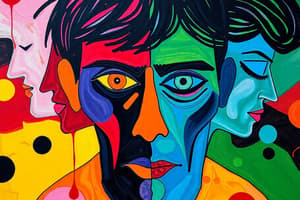Podcast
Questions and Answers
Which treatment approach focuses on helping individuals develop daily living skills?
Which treatment approach focuses on helping individuals develop daily living skills?
- Personal Therapy
- Community Mental Health Approach (correct)
- Relapse Plan
- Cognitive Behavioral Therapy
Which of the following is a key element of comprehensive care for individuals with schizophrenia?
Which of the following is a key element of comprehensive care for individuals with schizophrenia?
- Social Isolation
- Family Support (correct)
- Employment Disregard
- Individual Counseling Only
What aspect does the cognitive behavioral misinterpretation focus on?
What aspect does the cognitive behavioral misinterpretation focus on?
- Social dynamics
- Misinterpretation of stimuli (correct)
- Behavioral reinforcement
- Biological influences
What does the psychodynamic approach primarily address in schizophrenia?
What does the psychodynamic approach primarily address in schizophrenia?
Which factor is associated with sociocultural approaches to understanding schizophrenia?
Which factor is associated with sociocultural approaches to understanding schizophrenia?
Flashcards
Schizophrenia Symptoms
Schizophrenia Symptoms
A severe mental disorder characterized by disordered thinking, delusions, hallucinations, and abnormal behaviors
Schizophrenia Causes
Schizophrenia Causes
The exact cause is unknown, but likely a combination of genetic predisposition, brain abnormalities, and environmental factors
Schizophrenia Treatments
Schizophrenia Treatments
Treatment for schizophrenia typically includes medication, therapy, and support services
Comprehensive Care for Schizophrenia
Comprehensive Care for Schizophrenia
Signup and view all the flashcards
Schizophrenia Biological Causes
Schizophrenia Biological Causes
Signup and view all the flashcards
Study Notes
Symptoms and Causes
- Depression involves negative symptoms like social withdrawal, fatigue, alogia, anhedonia, and sadness. Mania includes positive symptoms such as impulsiveness, excitement, powerful emotions, and less need for sleep.
- Unipolar depression only includes depressive symptoms, while bipolar includes both manic and depressive episodes (at least a week of manic or hypomanic episode).
- Depression prevalence: 8% severe, 5% less severe, and 20% throughout a lifetime.
- Bipolar prevalence: 1-2.8% and 4.4% lifetime.
- Mania involves euphoric, overly positive emotions (sometimes irritability or anger), poor judgment, impulsivity, inflated self-esteem, very active and erratic behavior, heightened motivation (seeking constant excitement), and increased energy/need for less sleep.
- Depression involves anhedonia, emptiness, sadness, generally negative emotionality, brain fog, highly negative self-views, pessimism, social withdrawal, irritability, difficulty completing tasks, extreme fatigue, and sleep/appetite problems.
Treatments
- Psychodynamic therapy involves free association and therapist interpretation. This is sometimes helpful, but it can take a long time and lack of quick results or client motivation can make it ineffective.
- Cognitive behavioral therapy (CBT) helps people increase activities, improve mood, challenge negative thinking patterns, and change primary attitudes to help manage symptoms.
- Mindfulness-based cognitive therapy helps individuals recognize and accept thoughts.
- Social action/reducing barriers, and cultural sensitivity treatments to remove barriers to mental health access and reduce stigma.
- Interpersonal psychotherapy (IPT) focuses on interpersonal relationships (loss, role disputes, transitions, and deficits).
- Couples therapy can be helpful for dysfunctional relationships.
- Antidepressants, such as MAO inhibitors, tricyclics, and 2nd-generation antidepressants (SSRIs), help increase neurotransmitter production but have different side effects.
- Brain stimulation techniques like electroconvulsive therapy (ECT) and vagus nerve stimulation (VNS) and transcranial magnetic stimulation (TMS) can be effective for severe cases.
Other Points
- Intensity of stress leads to slower lymphocytes and more pro-inflammatory cytokines. Loss of significant others can lead to introjection.
- Cognitive behavioral therapy (CBT) involves identifying and addressing negative thoughts and behaviors. It is related to the belief that negative views of self are connected to experiences and errors in thinking.
- Sociocultural perspectives indicate a correlation between weak social support and declining social rewards, which leads to social withdrawal and a downward spiral. Women experience more stress and victimization, compared with men.
- Cultural factors may affect the experience and perception of depression, but ethnicity does not appear to influence rate of depression.
- Developmental psychopathology suggests early life experiences with negative factors (trauma, inadequate parenting) may predict later depression in response to stress.
- Bipolar disorder is characterized by manic and depressive episodes, and evidence suggests a strong biological component.
- Very high inheritability rates are reported in evidence for bipolar disorder.
- Schizophrenia involves positive (excesses) and negative (deficits) symptoms.
- Common positive symptoms include hallucinations, delusions (beliefs not based in reality), and disorganized thinking.
- Negative symptoms include hallucinations, difficulty expressing thoughts, and decreased effort.
- Some important concepts that are discussed in schizophrenia are down, social class drift, types of delusions, and the need for treatment and care.
- Biological factors like neurotransmitters play a crucial role in these disorders.
- Treatment often involves medications and lifestyle interventions including adequate housing, a relapse plan, and support from people to help with planning, and coordination of services.
Studying That Suits You
Use AI to generate personalized quizzes and flashcards to suit your learning preferences.




